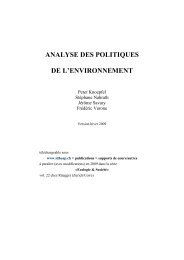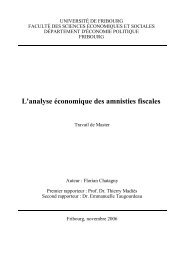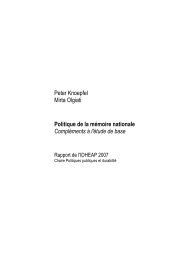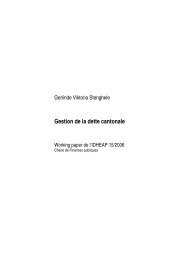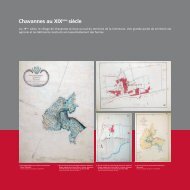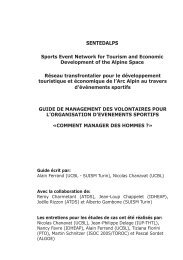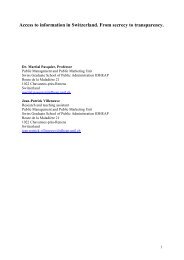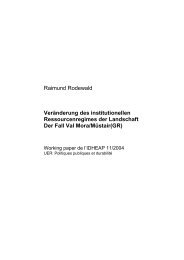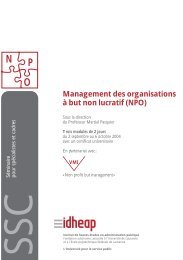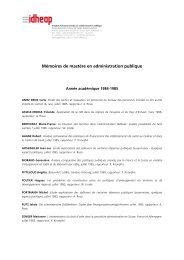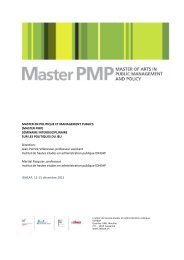Voting advice applications and party choice: evidence from ...
Voting advice applications and party choice: evidence from ...
Voting advice applications and party choice: evidence from ...
Create successful ePaper yourself
Turn your PDF publications into a flip-book with our unique Google optimized e-Paper software.
Int. J. Electronic Governance, Vol. 5, Nos. 3/4, 2012 367<br />
<strong>Voting</strong> <strong>advice</strong> <strong>applications</strong> <strong>and</strong> <strong>party</strong> <strong>choice</strong>:<br />
<strong>evidence</strong> <strong>from</strong> smartvote users in Switzerl<strong>and</strong><br />
Andreas Ladner, Jan Fivaz* <strong>and</strong><br />
Joëlle Pianzola<br />
IDHEAP,<br />
University of Lausanne,<br />
Lausanne, Switzerl<strong>and</strong><br />
Email: <strong>and</strong>reas.ladner@idheap.unil.ch<br />
Email: fivaz@nccr-democracy.uzh.ch<br />
Email: pianzola@nccr-democracy.uzh.ch<br />
*Corresponding author<br />
Abstract: Online voting <strong>advice</strong> <strong>applications</strong> (VAAs) have become popular<br />
across Europe with millions of voters using them during electoral campaigns.<br />
Despite their popularity, little is known about their impact on their users’<br />
electoral <strong>choice</strong>s. Based on survey data <strong>from</strong> voters using the Swiss VAA<br />
smartvote, we present findings on the direct impact on the actual votes of VAA<br />
users <strong>and</strong> whether the voting recommendations led them to adapt their previous<br />
vote <strong>choice</strong>s. Our findings suggest that there is a tendency toward swing voting<br />
among smartvote users, most prominently among younger voters. Moreover,<br />
we find that smartvote users who were very surprised by the outcome of<br />
their voting recommendations were also more inclined to change their <strong>party</strong><br />
<strong>choice</strong>s. Furthermore, we examine the directional change of the initial voting<br />
preferences of those voters who stated that the tool had influenced their voting<br />
decisions. Our findings are valid only for a self-selected sample of smartvote<br />
users; thus, we discuss necessary steps for improvement in future VAA<br />
research.<br />
Keywords: e-democracy; VAAs; elections; electoral <strong>choice</strong>; smartvote; voting<br />
recommendation; decision-making; swing-voting.<br />
Reference to this paper should be made as follows: Ladner, A., Fivaz, J. <strong>and</strong><br />
Pianzola, J. (2012) ‘<strong>Voting</strong> <strong>advice</strong> <strong>applications</strong> <strong>and</strong> <strong>party</strong> <strong>choice</strong>: <strong>evidence</strong><br />
<strong>from</strong> smartvote users in Switzerl<strong>and</strong>’, Int. J. Electronic Governance, Vol. 5,<br />
Nos. 3/4, pp.367–387.<br />
Biographical notes: Andreas Ladner is Professor for Political Institutions <strong>and</strong><br />
Swiss Public Administration at the autonomous university institute IDHEAP<br />
in Lausanne. His areas of research include political parties, municipalities,<br />
institutional change, <strong>and</strong> e-democracy. He has conducted several major<br />
research projects of the Swiss National Science Foundation <strong>and</strong> authored books<br />
<strong>and</strong> articles on these topics. His latest book analyses the influence of municipal<br />
size on the quality of democracy in Swiss municipalities. Actually he leads the<br />
research project on the voting assistance application (VAA) smartvote. He also<br />
regularly comments Swiss politics in the media.<br />
Jan Fivaz is writing his PhD in Political Science at the Autonomous University<br />
Institute IDHEAP in Lausanne. He is also working at as a research assistant at<br />
the University of Bern. His areas of research consist of electoral behaviour,<br />
Copyright © 2012 Inderscience Enterprises Ltd.
368 A. Ladner, J. Fivaz <strong>and</strong> J. Pianzola<br />
political parties, political representation, <strong>and</strong> eDemocracy. In 2009, he obtained<br />
a Master of Arts in History, Political Science <strong>and</strong> Economics. Since 2003, he<br />
has been involved in the development of the voting <strong>advice</strong> application (VAA)<br />
smartvote.<br />
Joëlle Pianzola studied Political Science, English Linguistics <strong>and</strong> European<br />
Law at the University of Bern <strong>and</strong> University of Helsinki. She is currently<br />
writing her PhD in Political Science at IDHEAP, University of Lausanne. Her<br />
research interests are electoral behaviour, political psychology, democratic<br />
processes <strong>and</strong> e-democracy.<br />
This paper is an revised <strong>and</strong> exp<strong>and</strong>ed version of a paper titled ‘Impact of<br />
voting <strong>advice</strong> <strong>applications</strong> on voters’ decision-making’ presented at the<br />
conference ‘Internet, Politics, Policy 2010: An Impact Assessment’, Oxford,<br />
16–17 September.<br />
1 Introduction<br />
<strong>Voting</strong> <strong>advice</strong> <strong>applications</strong> (VAAs) have become increasingly popular over the last<br />
several years. Today, they have established themselves as essential parts of most major<br />
electoral campaigns. During the 2007 electoral campaign in Switzerl<strong>and</strong>, the VAA<br />
smartvote (http://www.smartvote.ch) was used by about 375,000 voters (Fivaz <strong>and</strong><br />
Nadig, 2010; Ladner et al., 2010). In relation to the 2.4 million voters who participated in<br />
the election, this means that about 15% of voters used smartvote prior to their electoral<br />
decision-making.<br />
Similar developments can be observed in a number of other countries. In Germany,<br />
for instance, the VAA Wahl-O-Mat (http://www.wahl-o-mat.de) delivered 6.2 million<br />
voting recommendations for the 2009 elections, which corresponds to about 12% of the<br />
electorate (Garzia, 2010). The Netherl<strong>and</strong>s are probably the country where VAAs are<br />
most popular. In the weeks before the 2010 elections, the VAA Stemwijzer<br />
(http://www.stemwijzer.nl) delivered 4.2 million voting recommendations, while the<br />
VAA Kieskompas (http://www.kieskompas.nl) added another 1.5 million to the total of<br />
5.7 million voting recommendations (Louwerse <strong>and</strong> Rosema, 2011). Thus, the number of<br />
voting recommendations issued in 2010 corresponds to more than 50% of Dutch voters.<br />
With regard to this widespread popularity, it is not surprising that, in recent years,<br />
VAA-related research has drawn attention more <strong>and</strong> more to the question of whether<br />
VAAs affect the electoral decisions of their users. Several studies have conducted online<br />
surveys among VAA users <strong>and</strong> asked them directly whether the received voting<br />
recommendations had an impact on their <strong>party</strong> <strong>choice</strong>s. In the Swiss case, about 70% of<br />
users stated that they were affected by the VAA smartvote in their vote <strong>choice</strong>s (Ladner<br />
et al., 2010b). This is an unusually high figure <strong>and</strong> might be due to the complexity of the<br />
Swiss electoral system <strong>and</strong> the far-reaching possibilities involved in the voting process<br />
compared to other countries.<br />
Therefore, the smartvote users were asked more precisely how the smartvote<br />
recommendations affected their voting decisions. Only 15% of those who were<br />
influenced stated that they had adopted the recommendations in their entirety <strong>and</strong> copied<br />
them onto the ballot papers. The other users adopted the recommendations only partially.
<strong>Voting</strong> <strong>advice</strong> <strong>applications</strong> <strong>and</strong> <strong>party</strong> <strong>choice</strong> 369<br />
For instance, they listed c<strong>and</strong>idates <strong>from</strong> different lists on their ballot papers (so-called<br />
“panaschieren” or split voting), or they listed c<strong>and</strong>idates twice <strong>and</strong> thus gave them two<br />
votes (so-called “kumulieren” or cumulative voting) (Ladner et al., 2010).<br />
Therefore, the Swiss results need to be interpreted against the background of the<br />
specific Swiss electoral system, <strong>and</strong> they cannot be directly compared with results <strong>from</strong><br />
other countries. In other countries, VAA users were asked whether the use of VAAs had<br />
led to voting for a <strong>party</strong> other than the one originally intended. The resulting figures vary<br />
strongly depending on the country. In the Netherl<strong>and</strong>s, between 10% (Kleinnijenhuis<br />
et al., 2008) <strong>and</strong> 15% of users (Aarts <strong>and</strong> van der Kolk, 2007) claimed to have adjusted<br />
their electoral decisions due to the recommendations received. For Germany, this figure<br />
is 6% (Marschall, 2005), <strong>and</strong> for Finl<strong>and</strong>, it is as low as 3% (Mykkänen <strong>and</strong> Moring,<br />
2006).<br />
The VAA researchers themselves view these findings rather critically. Most of the<br />
cited studies are based on pre-electoral surveys. Correspondingly, what is captured are<br />
voting intentions <strong>and</strong> not real voting decisions. A Belgian study captured both voting<br />
intentions <strong>and</strong> voting decisions for the users of the VAA Do De Stemtest! by means of<br />
comparing data <strong>from</strong> pre- <strong>and</strong> post-electoral surveys. Among those users who said that<br />
the Stemtest had convinced them to vote for another <strong>party</strong>, only two-thirds effectively did<br />
so in the end. This study, thus, concludes that the evaluation of voting intentions is a very<br />
unreliable measure of the impact of VAAs. Post-electoral questioning leads to more<br />
reliable results (Walgrave et al., 2008). In addition, there is also the problem of an overreporting<br />
effect – a problem inherent to all survey-based research.<br />
Considering this critique on the direct measurement of a VAA’s impact, we decided<br />
to try to measure the potential impact of VAAs by means of an indirect impact<br />
measurement. In this study, we will examine whether those users who stated that they<br />
were influenced by the voting recommendations have a higher probability of swingvoting<br />
in elections.<br />
In the following section, we present a few theoretical insights into the question of<br />
why it can be expected that VAAs affect their users’ electoral decision-making. The third<br />
section contains information about the datasetused, <strong>and</strong> the following sections present<br />
our empirical analyses. We conclude with a discussion <strong>and</strong> outlook for future VAA<br />
research.<br />
2 Theoretical considerations<br />
Since there is hardly any theoretical-oriented literature on VAAs to be found, we are<br />
bound to apply findings <strong>and</strong> debates <strong>from</strong> the general literature on electoral behaviour to<br />
gain some theoretical foundations concerning the question of the expected influence of<br />
VAAs on their users’ electoral decision-making.<br />
What determines the electoral <strong>choice</strong>s of voters? State-of-the-art theories on electoral<br />
behaviour stress – besides other factors such as <strong>party</strong> attachment <strong>and</strong> affection for<br />
c<strong>and</strong>idates– the crucial role of issue voting (Niemi <strong>and</strong> Weisberg, 2001, p.14). A large<br />
number of studies have shown the decisive importance of political parties’ issue positions<br />
on a voter’s electoral <strong>choice</strong>s [e.g. Alvarez <strong>and</strong> Nagler, 2000; Powell, 2000; Kriesi <strong>and</strong><br />
Sciarini, 2003 (for the case of Switzerl<strong>and</strong>), <strong>and</strong> Schoen <strong>and</strong> Weiss, 2005].
370 A. Ladner, J. Fivaz <strong>and</strong> J. Pianzola<br />
Klein (2006, p.595) emphasises the importance of issue voting <strong>and</strong> describes,<br />
according to normative democratic theories, the ideal voter as follows: the ideal voter<br />
informs himself carefully about all the pressing political issues <strong>and</strong> the positions of<br />
political parties toward them. Then the voter compares the parties’ positions with his<br />
own preferences <strong>and</strong> makes voting decisions based on this matching. Klein concludes<br />
that the services provided by VAAs come very close to this normative ideal for electoral<br />
decision-making.<br />
All VAAs are based on the concept of issue voting or, to be more precise, on the<br />
well-known proximity model of Downs (1957). Downs’ original model had a simple<br />
setting that was based on an election with only one issue dimension (usually the left-right<br />
dimension) <strong>and</strong> only two competing c<strong>and</strong>idates. According to Downs, a voter will vote<br />
for the c<strong>and</strong>idate that is closest to one’s own position on the particular issue dimension.<br />
Downs’ model fits quite well for elections within the electoral system in the USA. Over<br />
the following years, the model was adapted to more complex electoral systems such as<br />
those in European countries (e.g. constituencies with more than one seat, <strong>party</strong> systems<br />
with more than two parties, or electoral systems with open lists; see Cox,1997). The<br />
model was also extended in the direction of including multiple issue dimensions instead<br />
of only one.<br />
By adapting the model to more complex electoral <strong>and</strong> <strong>party</strong> systems beyond that of<br />
the USA, the model itself increased in complexity. Today, the proximity-voting model is<br />
often criticised on the grounds that the average voter is not willing to or even capable<br />
of gathering <strong>and</strong> processing all the necessary information to perform the dem<strong>and</strong>ed<br />
comparison of policy positions. This might be feasible in the rather simplified original<br />
model, but clearly not in elections with multiple parties debating on a large number of<br />
political issues (Rabinowitz <strong>and</strong> MacDonald, 1989).<br />
This critique concerning voters’ limited information-collecting <strong>and</strong> informationprocessing<br />
capacities opens a link to VAAs because they seem to offer an interesting<br />
solution. VAAs reduce voters’ information <strong>and</strong> transaction costs at large (Jeitziner,<br />
2004). They provide easily accessible information on the policy positions of political<br />
parties <strong>and</strong> not only for one issue but for a large number of issues. Supported by a VAA,<br />
everyone should be capable of conducting his own personalised issue-matching with all<br />
the relevant political parties within a couple of minutes. Given the large number of voters<br />
using VAAs, they are obviously offering services that are needed <strong>and</strong> appreciated by<br />
voters.<br />
This leads us to our assumption that VAAs have an impact on the electoral <strong>choice</strong>s of<br />
the voters using them. This assumption is supported by an observation about voters’<br />
<strong>party</strong> attachment. Party attachment is seen within the social-psychological theory of<br />
voting as one of the main factors to explain voting decisions (e.g. Schoen <strong>and</strong> Weiss,<br />
2005). Voters use a close <strong>party</strong> identification as a kind of a shortcut or cue that allows<br />
them to reduce both the complexity <strong>and</strong> the cost of making a voting decision. However,<br />
the last ten to 20 years have shown a constant decline in voters’ <strong>party</strong> attachments in<br />
almost all advanced democracies. Voters’ ties to parties are loosening (e.g. there has been<br />
a decline in <strong>party</strong> memberships or growth in distrust of parties). Furthermore, their<br />
electoral behaviour has become more volatile <strong>and</strong> led to an increase in swing-voting<br />
(Dalton <strong>and</strong> Wattenberg, 2000; Dalton, 2006). Because of this evident decline, the<br />
explanatory power of <strong>party</strong> attachment for electoral <strong>choice</strong> seems questionable, <strong>and</strong> it<br />
leads to the assumption that voters might be more open to seeking new cues with respect<br />
to their voting decisions.
<strong>Voting</strong> <strong>advice</strong> <strong>applications</strong> <strong>and</strong> <strong>party</strong> <strong>choice</strong> 371<br />
Finally, research on the impact of electoral systems on electoral behaviour <strong>and</strong><br />
electoral outcome offers some support for our assumption concerning the impact of<br />
VAAs. In his seminal work, Duverger (1959) stated that electoral systems based on<br />
proportional representation lead to <strong>party</strong> systems with more than two parties. More recent<br />
research supports this view <strong>and</strong> could further show that, with an increasing number of<br />
seats per electoral district, the number of parties <strong>and</strong> c<strong>and</strong>idates is also increasing (Cox,<br />
1997). In addition, the findings presented by Ezrow (2010) indicate that larger electoral<br />
districts also lead to more niche parties, which address issues that are more or less<br />
neglected by the traditional parties. To sum up, proportional representation combined<br />
with the increasing size of electoral districts leads to a large <strong>and</strong> growing offer of parties<br />
– <strong>from</strong> quantitative as well as thematic perspectives – on which voters can base their<br />
electoral decisions. These exp<strong>and</strong>ed offerings again make it more difficult <strong>and</strong> timeconsuming<br />
for voters to find suitable parties or c<strong>and</strong>idates to vote for (Sartori, 1968; Cox,<br />
1997). Thus, it is reasonable to assume that, at least in large districts, VAAs could offer<br />
some assistance in this regard.<br />
Even though there are – as we could show – several good reasons to assume that<br />
VAAs affect voters’ electoral <strong>choice</strong>s, the findings of the few existing empirical studies<br />
on this topic show contradictory results. Walgrave et al. (2008) analysed the Belgian<br />
VAA Stemtest (“Do the Vote Test”) <strong>and</strong> its impact on voters during the 2004 election<br />
campaign in Belgium. They found <strong>evidence</strong> that the Stemtest affected Belgian voters in<br />
their electoral <strong>choice</strong>s but only on a very modest level. These findings about the limited<br />
effect of VAAs are somewhat in contrast to those of other studies. Both Kleinnijenhuis et<br />
al. (2007) <strong>and</strong> Rusuuvirta <strong>and</strong> Rosema (2009) found <strong>evidence</strong> that, in elections in the<br />
Netherl<strong>and</strong>s, VAAs played an important role <strong>and</strong> had a clear impact on the voting<br />
decisions of Dutch voters.<br />
In our study, we trace the possibility of whether the information about parties <strong>and</strong><br />
c<strong>and</strong>idates provided by smartvote influences people in their voting decisions <strong>and</strong> whether<br />
this influence might eventually lead voters to rethink their initial <strong>party</strong> preferences.<br />
Although we cannot make any causal claims regarding the relationship between the VAA<br />
voting recommendations <strong>and</strong> the final vote <strong>choice</strong>s of voters, we can nevertheless<br />
examine whether we find higher occurrences of swing-voting among those smartvote<br />
users who report that they were, in fact, receptive toward the voting <strong>advice</strong> given to them<br />
by smartvote.<br />
3 Data<br />
Against the background of the 2007 Swiss parliamentary elections, the NCCR Democracy<br />
research project conducted two surveys among the users of smartvote. 1 The first survey<br />
started before the election. After receiving their voting recommendations, users were<br />
asked to participate in the additional NCCR survey by clicking on a link that led them to<br />
a special website where they could fill out the pre-election survey, which included<br />
questions about socio-demographic characteristics, voting behaviour in previous<br />
elections, <strong>and</strong> voting intentions with regard to the upcoming election. Some days after the<br />
election, the respondents received an e-mail <strong>and</strong> were asked to fill out the post-election<br />
survey, which focused on actual voting behaviour in the 2007 elections. In total, 4331<br />
users completed this survey.<br />
In addition, a second post-election survey was conducted. This second survey<br />
comprised both parts of the first survey <strong>and</strong> was conducted after the election. Smartvote<br />
offers its users the opportunity to create their own user accounts on the website to save
372 A. Ladner, J. Fivaz <strong>and</strong> J. Pianzola<br />
their answers <strong>and</strong> results <strong>and</strong> to receive additional services. In 2007, a total of 80,225<br />
users owned such accounts. A few days after the elections, all smartvote users with a user<br />
account received an e-mail <strong>and</strong> were asked to support the NCCR research project <strong>and</strong> to<br />
participate in this second survey, <strong>and</strong> 13,959 of them did so.<br />
Data <strong>from</strong> both surveys could be merged into one combined dataset comprising<br />
18,290 respondents in total. Although the data contains a large number of respondents,<br />
we cannot claim that it is representative with regard to the entire population of smartvote<br />
users. That the data stems <strong>from</strong> a self-selected group of smartvote users has to be kept in<br />
mind with regard to the empirical analysis.<br />
To determine the validity of our data, we cross-checked the socio-demographic<br />
profile of smartvote users with the findings of several previous studies. First, we checked<br />
our socio-demographic profile of smartvote users with the profile of a previous study<br />
conducted by Fivaz <strong>and</strong> Nadig (2010). Instead of the NCCR survey data, they used data<br />
<strong>from</strong> the Swiss electoral study (Selects), a representative telephone-based survey. We<br />
found a very similar pattern in both profiles of smartvote users. Furthermore, we also<br />
compared our profile with those of VAA users in other countries (Marchall, 2005;<br />
Marschall <strong>and</strong> Schmidt, 2010; Wall et al., 2009) <strong>and</strong> again found similar patterns. In our<br />
own data as well as in all available studies, the typical VAA user is male, young, <strong>and</strong><br />
well-educated. He also has a high interest in politics <strong>and</strong> exhibits above-average political<br />
activity.<br />
Therefore, we can assume that this dataset is of sufficient quality for the results to be<br />
comparable to those of VAA research <strong>from</strong> other countries. Our aim is not to draw any<br />
general conclusions with regard to the overall impact of smartvote on the elections but,<br />
rather, to remain in the realm of how the tool affected those who actually used it <strong>and</strong><br />
answered our surveys.<br />
4 First analyses: direct impact measurement<br />
The post-electoral surveys conducted among smartvote users contained a number of<br />
questions aimed directly at measuring the potential impact of smartvote. Survey<br />
participants were asked whether the use of smartvote had a direct influence on their<br />
voting decisions or not <strong>and</strong>, if so, how exactly smartvote affected their decisions.<br />
Asked directly, 67% of the respondents stated that smartvote had affected their voting<br />
decisions. These findings differ to a large extent <strong>from</strong> results of similar studies for<br />
Germany, the Netherl<strong>and</strong>s, <strong>and</strong> Belgium. According to Marschall (2005), in Germany,<br />
only 6% of voters using a VAA were directly affected in their electoral decision, <strong>and</strong> in<br />
Belgium, VAAs had an impact only on a small percentage of their users (Walgrave et al.,<br />
2008). Research results for the Netherl<strong>and</strong>s show higher values (Aarts <strong>and</strong> van der Kolk,<br />
2007), but at 15%, there is still a significant difference <strong>from</strong> the 67% we found for<br />
Switzerl<strong>and</strong>. We will return to this aspect later.<br />
In the following tables, we present descriptive statistics about the influence of<br />
smartvote on different user groups. Table 1 shows the share of influenced users with<br />
regard to age, gender, <strong>and</strong> educational level.<br />
Table 1 shows that there are only minor differences between voters with regard to<br />
educational level or gender. The largest differences by far can be found between the<br />
several age groups. The influence of smartvote on voting decisions is strongest among<br />
young voters.
<strong>Voting</strong> <strong>advice</strong> <strong>applications</strong> <strong>and</strong> <strong>party</strong> <strong>choice</strong> 373<br />
Table 1 Influence of smartvote on voting decisions – Part 1<br />
Age groups<br />
Share of smartvote users (voters) influenced in their voting decisions<br />
Yes (%) No (%) N (=100%)<br />
18–24 71 29 3346<br />
25–34 73 27 4759<br />
35–44 68 32 3461<br />
45–54 59 41 2400<br />
55–64 54 46 1637<br />
65+ 48 52 711<br />
Gender<br />
Male 65 35 11,382<br />
Female 70 30 4968<br />
Educational Level<br />
Low 69 31 490<br />
Middle 66 34 5850<br />
High 67 33 9774<br />
Source: NCCR “Democracy”, IP16 “smart-voting 2.0” (http://www.nccr-democracy.<br />
uzh.ch/research/module5/smart-voting/smart-voting)<br />
One distinct aspect of the Swiss electoral system is the large variance between the<br />
electoral districts (cantons) with regard to their size. The number of seats (M) per<br />
constituency differs between one <strong>and</strong> 34. Subsequently, the number of c<strong>and</strong>idates (C)<br />
running for a seat also differs to a large degree. In Table 2, we compare the ratio between<br />
C <strong>and</strong> M – in other words, the number of c<strong>and</strong>idates per seat – with the impact of<br />
smartvote on its users. The more c<strong>and</strong>idates are running for a seat, the more information<br />
has to be gathered <strong>and</strong> processed by voters. Thus, the aforementioned information<br />
problem of voters is most pressing in those constituencies with the highest C/M ratio.<br />
Due to this factor, we assume that the influence of VAAs is stronger in constituencies<br />
with more c<strong>and</strong>idates running for a seat.<br />
Table 2 Influence of smartvote on voting decisions – Part 2<br />
C/M ratio*<br />
Share of smartvote users (voters) influenced in their voting decisions<br />
Yes (%) No (%) N (=100%)<br />
1 22 78 46<br />
3 13 87 16<br />
4 33 67 42<br />
7 52 48 103<br />
8 31 69 99<br />
9 54 46 474<br />
10 50 50 221
374 A. Ladner, J. Fivaz <strong>and</strong> J. Pianzola<br />
Table 2<br />
Influence of smartvote on voting decisions – Part 2 (continued)<br />
C/M ratio*<br />
Share of smartvote users (voters) influenced in their voting decisions<br />
Yes (%) No (%) N (=100%)<br />
11 59 41 1087<br />
12 60 40 2514<br />
13 72 28 1147<br />
16 68 32 1448<br />
18 62 38 407<br />
19 66 34 1453<br />
20 72 28 3376<br />
24 72 28 3941<br />
Total 67 33 16,374<br />
Source: NCCR “Democracy”, IP16 “smart-voting 2.0” (http://www.nccr-democracy.<br />
uzh.ch/research/module5/smart-voting/smart-voting)<br />
Notes: *C/M-ratio: the numerical relation between the number of c<strong>and</strong>idates (C) <strong>and</strong><br />
the number of seats (M) in a particular constituency. The higher the C/M ratio<br />
is, the more c<strong>and</strong>idates are competing against each other per seat.<br />
Indeed, Table 2 supports our assumption. The higher the C/M ratio in a constituency is,<br />
the more smartvote users were affected in their voting decisions by the voting<br />
recommendations they received.<br />
With regard to the Swiss electoral system, voters have multiple options at their<br />
disposal to express their political preferences on the ballots. Hence, voters using<br />
smartvote were also asked how, in particular, they were affected in their electoral <strong>choice</strong>s<br />
(see Table 3).<br />
Table 3<br />
Influence of smartvote on voting decisions (in percentage)<br />
Yes (%) No (%) N (=100%)<br />
Did you copy the smartvote recommendations<br />
without any changes onto your voting list?<br />
Based on the smartvote recommendations, did<br />
you vote for c<strong>and</strong>idates <strong>from</strong> different lists (votesplitting)?<br />
Based on the smartvote recommendations, did you<br />
vote for parties <strong>and</strong> c<strong>and</strong>idates that you would<br />
otherwise not have voted for?<br />
Based on the smartvote recommendations, did you<br />
abstain <strong>from</strong> voting for parties <strong>and</strong> c<strong>and</strong>idates you<br />
would otherwise have voted for?<br />
15 85 10,650<br />
61 39 10,580<br />
67 33 10,559<br />
35 65 10,372<br />
Source: NCCR “Democracy”, IP16 “smart-voting 2.0” (http://www.nccr-democracy.<br />
uzh.ch/research/module5/smart-voting/smart-voting).<br />
According to Table 3, only a small number of voters copied the voting recommendations<br />
without any changes onto their ballots. This indicates that VAAs do not produce a kind<br />
of an “instant voter” whose voting decisions are completely computer-generated without<br />
reflection on the results. In fact, the opposite seems to be the case. As we can see <strong>from</strong>
<strong>Voting</strong> <strong>advice</strong> <strong>applications</strong> <strong>and</strong> <strong>party</strong> <strong>choice</strong> 375<br />
Table 3, most of the voters used the voting recommendations to refine their ballots. Due<br />
to smartvote, they split their votes more often <strong>and</strong> also voted more often for c<strong>and</strong>idates<br />
that they otherwise would have overlooked. These findings are in line with <strong>evidence</strong><br />
<strong>from</strong> another study, which could show that users do not trust smartvote blindly but that<br />
they use it as a starting point for gathering further information about the c<strong>and</strong>idates<br />
ranking highest in their voting recommendations (Fivaz <strong>and</strong> Nadig, 2010). For our later<br />
analysis, it is particularly interesting to see that two-thirds of users indicated that they<br />
voted for parties or c<strong>and</strong>idates that they otherwise would not have voted for. We will<br />
follow up on this tendency when we assess whether those who were influenced by the<br />
tool in their decisions actually changed their vote <strong>choice</strong>s to another <strong>party</strong> – an impact<br />
that would have the strongest consequences for the elections in general.<br />
So far, the survey answers of users show that some smartvote users had been strongly<br />
influenced by the tool in their voting decisions. Even though not all users are affected to<br />
the same degree, the impact on all groups of users is on, an average, several times higher<br />
than that observed in other countries. Whether this is due to country specifics of the<br />
election process, the tool, or simply an artefact of the self-selected sample cannot be<br />
determined at this point. The next section offers a more in-depth analysis of potential<br />
impacts of the tool on voters by focusing on actual changes in the voting behaviour of<br />
users.<br />
5 In-depth analyses: swing voters among smartvote users<br />
As presented in the previous section, a large majority of smartvote users in our sample<br />
stated that the tool affected their vote <strong>choice</strong>s. However, we likewise mentioned that we<br />
do not know whether this influence was actually exercised at the polls. As Walgrave<br />
et al.’s (2008) study on the 2004 Belgian elections suggests, VAAs seem to affect<br />
people’s vote intentions <strong>and</strong>, to a lesser degree, their actual vote <strong>choice</strong>s. According to<br />
the authors, people tend to report that the voting recommendations affected their vote<br />
intention but do not exhibit this change of mind at the polls. Since the chance of overreporting<br />
the effects of the tool is great, we will now use a different indicator to measure<br />
the potential influences of smartvote on people’s voting behaviour. Instead of the direct<br />
question used in the preceding section, we will use swing-voting as an alternative,<br />
indirect impact measurement. As outlined earlier, a majority of users stated that they<br />
ended up voting for someone that they would not have considered before using the tool.<br />
Our question is, therefore, whether we can observe an effective vote change among those<br />
users who reported that the tool influenced their vote <strong>choice</strong>s.<br />
Swing voters are defined as voters who changed their <strong>party</strong> <strong>choice</strong>s in 2007 compared<br />
to their <strong>party</strong> <strong>choice</strong>s in the previous elections. Since the voting recommendations are<br />
based on extensive policy congruence, chances are that these services reveal a matching<br />
outcome that is different <strong>from</strong> what people might have expected. Furthermore, since they<br />
gain additional information, it is likely that this might alter the perception that people<br />
have of parties or c<strong>and</strong>idates. If they then place enough trust in the tool <strong>and</strong> are<br />
convinced by the outcome, they might be inclined to adapt their initial <strong>choice</strong>s<br />
accordingly. At the same time, it is also likely that those who do not have clear-cut<br />
preferences with regard to their <strong>party</strong> <strong>choice</strong>s or are uncertain about which <strong>party</strong> they
376 A. Ladner, J. Fivaz <strong>and</strong> J. Pianzola<br />
should vote for are more amenable toward the services provided by VAAs. The<br />
following table presents the bivariate association between those voters who reported that<br />
the tool had influenced their vote <strong>choice</strong>s <strong>and</strong> swing-voting.<br />
Table 4<br />
Swing voters influenced by smartvote in their voting decisions<br />
Reported to be influenced by smartvote in their votes <strong>choice</strong>s<br />
Yes (%) No (%) N(=100%)<br />
Swing voters<br />
Yes 73 27 4426<br />
No 56 44 7082<br />
Total 63 37 11,508<br />
Source: NCCR “Democracy”, IP16 “smart-voting 2.0” (http://www.nccr-democracy.<br />
uzh.ch/research/module5/smart-voting/smart-voting).<br />
As expected, those who stated that they were influenced by the voting recommendations<br />
in their vote <strong>choice</strong>s are also more likely to swing-vote (73% vs. 56%). In the next step,<br />
we will assess whether being influenced by the smartvote voting recommendations holds<br />
as a significant predictor for vote change if we control for relevant covariates. Through a<br />
logistic regression, we ascertain the probability of vote change based on the influence<br />
that smartvote had on users. The aim is to determine whether the previous illustrated<br />
differences can be maintained if we take other relevant factors into account. It has to be<br />
stressed beforeh<strong>and</strong> that any findings hold only for the sample at h<strong>and</strong>.<br />
The dependent variable in our logistic regression is vote change between elections.<br />
The dichotomised variable takes on the value of 1 if respondents changed their vote<br />
<strong>choice</strong>s in comparison to the previous elections <strong>and</strong> 0 if they did not change their vote<br />
<strong>choice</strong>s. The variable “influenced by voting recommendations” is also binary <strong>and</strong><br />
indicates whether voters reported that smartvote affected their vote <strong>choice</strong>s. We also<br />
assess how much the nature of the voting recommendations influences the probability of<br />
swing-voting. We asked participants whether the voting recommendations they received<br />
met their expectations or whether they were surprised by the results they got. The<br />
reception of the voting recommendations was measured on a 4-point scale; thus, three<br />
dummies <strong>and</strong> their respective reference categories are used as covariates in the model.<br />
We expect that, on average, the likelihood of swing-voting increases with the surprise of<br />
a voter about the voting recommendations. The reasoning behind this is as follows: if a<br />
voter is surprised by the voting recommendations, the recommended parties/c<strong>and</strong>idates<br />
most likely differ <strong>from</strong> that of voters’ initial <strong>party</strong> preferences (otherwise, she would not<br />
be surprised). If the voter is convinced by the voting recommendations, she might adapt<br />
her initial <strong>choice</strong>s <strong>and</strong> vote in accordance with the voting recommendations (swingvoting<br />
if this occurs on the <strong>party</strong> level). At the same time, surprising voting<br />
recommendations might also cause the opposite reaction in that the voter dismisses it<br />
altogether. In any case, a voter who receives voting recommendations that meets her<br />
expectations is most likely simply strengthened in going along with her initial <strong>party</strong><br />
<strong>choice</strong>s (thus yielding no swing-voting). On average, therefore, we expect that surprising<br />
voting recommendations is more likely to trigger swing-voting than expected results in<br />
the voting recommendations.
<strong>Voting</strong> <strong>advice</strong> <strong>applications</strong> <strong>and</strong> <strong>party</strong> <strong>choice</strong> 377<br />
A further important (continuous) covariate that we take into account is age. We show,<br />
based on direct measurement, that the impact of smartvote on voting decisions decreases<br />
with the increasing age of the voters (see Table 1). This finding is supported by a<br />
previous study, which also found <strong>evidence</strong> that younger voters were more likely to be<br />
influenced by the voting recommendations in their vote <strong>choice</strong>s (Fivaz <strong>and</strong> Nadig, 2010,<br />
p.182). This could result <strong>from</strong> the fact that political preferences tend to become more<br />
consolidated with increasing age <strong>and</strong> are, thus, less amenable to newly encountered<br />
information. At the same time, younger users are more familiar with online-based<br />
communication <strong>and</strong> information <strong>and</strong> might, thus, be less sceptical with regard to its<br />
services. Whatever the case, similar mechanisms might be at play in terms of a higher<br />
tendency to adapt <strong>party</strong> preferences among younger voters. Hence, we not only expect<br />
that younger voters are more likely to adapt initial <strong>party</strong> preferences but we also expect<br />
age to condition the effect that the voting recommendations have on swing voting. In<br />
other words, the assumption is that the probability of swing-voting among those who<br />
were influenced by the voting recommendations compared to those who were not is<br />
higher among younger voters than among older voters. Therefore, we add an interaction<br />
term (age*influenced by voting recommendation) in our model to examine whether the<br />
influence of the voting recommendations on swing-voting is moderated by age.<br />
Further covariates that could boost the probability of vote change are political<br />
ideology <strong>and</strong> multiple vote propensities. Voters in the middle of the political spectrum<br />
are expected to be more inclined to switch between available parties. Multiple vote<br />
propensities measure whether a voter has an inclination to vote for more than one <strong>party</strong><br />
with a very high likelihood. The “vote propensity question” in election surveys asks<br />
voters to indicate the likelihood that they will ever vote for specific parties on an 11-point<br />
scale (Van der Eijk et al., 2006; Van der Eijk <strong>and</strong> Franklin, 2009). Those voters who<br />
indicate high likelihoods (vote propensities higher than 8) for one or more <strong>party</strong> besides<br />
their most preferred one are coded as voters with multiple vote propensities. This binary<br />
covariate is of utmost importance since it controls to some degree the fact that voters<br />
with several <strong>party</strong> preferences might be more inclined to swing-vote <strong>and</strong> more<br />
susceptible tothe services provided by VAAs. A binary measure for <strong>party</strong> attachment is<br />
included since we expect that strong <strong>party</strong> followers are less likely to adapt their vote<br />
intentions.<br />
To control for contextual circumstances, we included variables that measure the<br />
degree of competition in the different constituencies in Switzerl<strong>and</strong>. The ratio of<br />
competing c<strong>and</strong>idates per available seat indicates the degree of variation for <strong>choice</strong>s – the<br />
higher the competition is for the available seat, the bigger the <strong>choice</strong> set <strong>and</strong> the higher<br />
the probability are for deciding on a c<strong>and</strong>idate <strong>from</strong> a different <strong>party</strong>. Thus, we controlled<br />
for the variation within cantons by including 14 dummies for the 15 different district<br />
magnitudes in our model. We also controlled for socio-demographic indicators such as<br />
gender, education, <strong>and</strong> income. Table 5 contains the corresponding results (the full model<br />
including all 14 dummies <strong>and</strong> 15 district seizes is attached in the Appendix A).<br />
In logistic regressions with interactions present, the interpretation of the results<br />
differs substantially <strong>from</strong> a regular regression. Without elaborating on the technicalities<br />
behind it (cf. Norton et al., 2004), the sign <strong>and</strong> the significance of the interaction<br />
coefficient <strong>and</strong> the corresponding single coefficients cannot be directly interpreted <strong>from</strong><br />
the model. Thus, as recommended by Long <strong>and</strong> Freese (2006), we plot predicted<br />
probabilities based on the main variables of interest <strong>and</strong> their interaction (influenced by
378 A. Ladner, J. Fivaz <strong>and</strong> J. Pianzola<br />
the voting recommendations, age, <strong>and</strong> the respective interaction). Figure 1 illustrates the<br />
predicted probabilities for swing-voting for those who were influenced by the smartvote<br />
voting recommendations (black dots) versus those who were not influenced by it (blue<br />
dots) for different age levels. The vertical confidence intervals indicate the relative<br />
significance of the predicted point estimates.<br />
Table 5<br />
Logit predictions for <strong>party</strong> change<br />
Independent variables<br />
Influenced by voting recommendations<br />
Age<br />
Age*influenced by voting recommendations<br />
Rather unsurprised by voting recommendations<br />
Rather surprised by voting recommendations<br />
Very surprised by voting recommendations<br />
Multiple vote propensities<br />
Party attachment<br />
Ideology (centre vs. left/right)<br />
Gender<br />
Educational level<br />
Income level<br />
Vote change<br />
0.60*<br />
(0.31)<br />
–0.01***<br />
(0.00)<br />
–0.006<br />
(0.007)<br />
0.12<br />
(0.11)<br />
0.18<br />
(0.14)<br />
0.69***<br />
(0.28)<br />
0.30***<br />
(0.11)<br />
–0.44***<br />
(0.09)<br />
0.36***<br />
(0.09)<br />
–0.11<br />
(0.10)<br />
0.00<br />
(0.06)<br />
–0.02<br />
(0.03)<br />
Constant<br />
–0.39<br />
(0.83)<br />
Observations 2551<br />
Log likelihood –1620<br />
Log likelihood 0 –1705<br />
AIC 3295<br />
Correctly predicted cases 64%<br />
Source: NCCR “Democracy”, IP16 “smart-voting 2.0” (http://www.nccr-democracy.<br />
uzh.ch/research/module5/smart-voting/smart-voting).<br />
Notes: St<strong>and</strong>ard errors in parentheses; *** p
<strong>Voting</strong> <strong>advice</strong> <strong>applications</strong> <strong>and</strong> <strong>party</strong> <strong>choice</strong> 379<br />
Figure 1 Predicted probabilities for vote change for influenced vs. not-influenced smartvote<br />
users based on specific values for age (see online version for colours)<br />
Predicted Probabilities for Vote Change<br />
.2 .3 .4 .5 .6<br />
20 30 40 50 60 70<br />
Age<br />
Not influenced<br />
Influenced<br />
95% CI<br />
95% CI<br />
Source: NCCR “Democracy”, IP16 “smart-voting 2.0” (http://www.nccr-democracy.<br />
uzh.ch/research/module5/smart-voting/smart-voting). Author’s calculations.<br />
Note: Predicted probabilities for vote change among those who were influenced <strong>and</strong><br />
those who were not influenced at specific values for age, averaged over the<br />
remaining covariates.<br />
Figure 1 illustrates that young voters who were influenced by the voting recommendations<br />
have a higher probability than older voters to change their vote <strong>choice</strong>s. Moreover, the<br />
probability of swing-voting is higher among those who were influenced by the voting<br />
recommendations than among those who were not influenced in their vote <strong>choice</strong>s. The<br />
confidence intervals around the point estimates indicate that the difference between the<br />
two groups is significant, with the exception of the age groups of 60 <strong>and</strong> 70. This is most<br />
likely due to the small sample size in these categories, which make a precise estimation<br />
more difficult (indicated by the larger confidence intervals). The exact values of the point<br />
estimates are not relevant in this context since they are dependent <strong>and</strong> vary according to<br />
the values set for the covariates. We are interested only in the differences <strong>and</strong><br />
significance of the point estimates, which, in our case, remain stable even if we specify<br />
different values for the remaining covariates. In sum, the estimated model indicates that<br />
the probability for swing voting is higher among those smartvote users who indicated that<br />
they were influenced by the voting recommendations <strong>and</strong> more so for younger users than<br />
for older users.
380 A. Ladner, J. Fivaz <strong>and</strong> J. Pianzola<br />
Furthermore, the model indicates that voters who were surprised by the voting<br />
recommendations they received were more likely to swing-vote compared to those who<br />
were not surprised by them. The probability of swing-voting, however, significantly<br />
increases only for those who were very surprised by the voting recommendations, but not<br />
so for those who were only somewhat surprised by it. Although still a far stretch, this<br />
result suggests that voters who were particularly surprised by the recommended parties<br />
<strong>and</strong> c<strong>and</strong>idates they received might have been inclined to adapt their initial vote <strong>choice</strong>s<br />
accordingly.<br />
As expected, voters in the middle of the political spectrum <strong>and</strong> voters with multiple<br />
vote propensities are more likely to swing vote, while <strong>party</strong> attachment decreases the<br />
likelihood of swing-voting. The number of c<strong>and</strong>idates running per seat also matters, with<br />
higher competition increasing the likelihood of swing-voting among voters in that<br />
constituency. The remaining socio-demographic variables are not significant predictors.<br />
Although the explanatory power of the model is rather weak given the model fit<br />
measures, the number of correctly predicted cases based on the model is substantially<br />
higher compared to r<strong>and</strong>om chance (64% vs. 39%). In this paper, we are mainly<br />
interested in detecting theorised implications while being aware that there is still variance<br />
to be explained. In general, we do not make any claims about effects but remain in the<br />
realm of predictions. The data at h<strong>and</strong> stems <strong>from</strong> a non-r<strong>and</strong>om, self-selected sample of<br />
smartvote users, limiting any sort of interpretation to that specific sample. To improve<br />
the analysis, experimental data or measures to correct for self-selection need to be<br />
taken; only then can any general claims be made. For now, we acknowledge these<br />
shortcomings.<br />
All things considered, the model supports our assumption that voters see smartvote as<br />
a serious <strong>and</strong> useful tool for their decision-making, one that can affect their actual vote.<br />
Thus, the findings in this section go along with those of the previous section. One<br />
argument that might strengthen our findings is that, due to the definition of swing-voting,<br />
we had to exclude those voters who were not eligible to vote in 2003 (the youngest<br />
users). Since it is this age cohort in particular that uses smartvote most frequently <strong>and</strong> is<br />
also most amenable to the tool, we can expect that an analysis that takes those voters into<br />
account as well finds even stronger support for an influence of the tool on decisionmaking.<br />
Another argument that might weaken our findings is that our specific sample<br />
might lead to such strong results. Chances are that convinced <strong>and</strong> highly enthusiastic<br />
smartvote users might have self-selected themselves into taking our survey; thus, we<br />
report a strong influence of the tool among a strongly influenced sample of smartvote<br />
users. For now, we can conclude only that some young smartvote users <strong>and</strong> those who<br />
were most surprised by the voting recommendations have a higher probability of<br />
changing their vote <strong>choice</strong>s between elections.<br />
6 Party change: winners <strong>and</strong> losers<br />
Since our findings suggest that influenced smartvote users are prone to change their vote<br />
<strong>choice</strong>s, our next <strong>and</strong> last step in this analysis is to take a look at the direction of their<br />
vote change. Table 6 shows the flow of votes between the elections of 2003 <strong>and</strong> 2007 for<br />
those voters who were influenced in their vote <strong>choice</strong>s by smartvote.
<strong>Voting</strong> <strong>advice</strong> <strong>applications</strong> <strong>and</strong> <strong>party</strong> <strong>choice</strong> 381<br />
Table 6<br />
Party change between the 2003 <strong>and</strong> 2007 elections among those who were influenced<br />
in their vote decisions by smartvote<br />
Party voted<br />
for in 2003<br />
Party voted for in 2007<br />
CVP FDP SVP SP GPS GLP<br />
Total<br />
CVP<br />
FDP<br />
SVP<br />
SP<br />
GPS<br />
Total<br />
N 59 17 55 41 62 234<br />
% 25.2 7.3 23.5 17.5 26.5 100.0<br />
N 152 99 46 45 135 477<br />
% 31.9 20.8 9.6 9.4 28.3 100.0<br />
N 48 89 19 9 23 188<br />
% 25.5 47.3 10.1 4.8 12.2 100.0<br />
N 135 137 22 728 251 1273<br />
% 10.6 10.8 1.7 57.2 19.7 100.0<br />
N 28 16 6 178 117 345<br />
% 8.1 4.6 1.7 51.6 33.9 100.0<br />
N 363 301 144 298 823 588 2517<br />
% 14.4 12.0 5.7 11.8 32.7 23.4 100.0<br />
Source: NCCR “Democracy”, IP16 “smart-voting 2.0” (http://www.nccr-democracy.<br />
uzh.ch/research/module5/smart-voting/smart-voting).<br />
Notes: Only the major five parties in Switzerl<strong>and</strong> plus the Green-liberals are included<br />
in this table. CVP = Christian-democrats; FDP = Liberal-democrats; SVP =<br />
National-conservatives; SP = Social Democrats; GPS = Greens; GLP = Greenliberals.<br />
The Green-liberals is a new <strong>party</strong> <strong>and</strong> did not run in the 2003<br />
elections.<br />
With regard to the five major parties in Switzerl<strong>and</strong>, a remarkable number of smartvote<br />
users changed their vote to the Green-liberals, a newly founded <strong>party</strong> that ran for seats in<br />
a national election for the first time in 2007. In general, the percentage values indicate<br />
that the major flow of votes is restricted to parties with similar ideological positions. The<br />
largest movement of voters can be found between the Greens <strong>and</strong> the Social Democrats<br />
on the left side of the political spectrum <strong>and</strong> between the Liberals <strong>and</strong> the Nationalconservatives<br />
on the right side. The Christian-democrats, as the classic centre <strong>party</strong>, gains<br />
<strong>and</strong> loses voters to both sides. In contrast, the flows of voters between the parties on the<br />
poles are rather small.2<br />
If we look at the votes received <strong>and</strong> lost by the different parties due to smartvote<br />
users, we find on the winning side the Green-liberals (plus 588 votes) followed by the<br />
Greens (plus 478 votes) <strong>and</strong> the Christian-democrats (plus 129 votes). Among the losing<br />
parties are, first, the Social Democrats (minus 975 votes), followed by the Liberaldemocrats<br />
(minus 176 votes) <strong>and</strong> the National-conservatives (minus 44 votes). These<br />
findings should not be overrated due to the aforementioned problems of the data sample,<br />
but they indicate to some degree which <strong>party</strong> gained <strong>and</strong> which <strong>party</strong> lost votes through<br />
smartvote.
382 A. Ladner, J. Fivaz <strong>and</strong> J. Pianzola<br />
According to our data, there are substantially more left-wing voters among smartvote<br />
users than right-wing voters. Previous research also showed that the typical smartvote<br />
user differs noticeably <strong>from</strong> the typical voter: the smartvote user is younger, better<br />
educated, with a clearly above average political knowledge <strong>and</strong> interest, <strong>and</strong> is<br />
predominantly male (Fivaz <strong>and</strong> Nadig, 2010). Hence, to establish the real extent of the<br />
impact on the election, we would have to know more about the entire population of<br />
smartvote users.<br />
7 Conclusions<br />
VAAs have become increasingly popular <strong>and</strong> emerged as indispensable elements in<br />
electoral campaigns (Marschall <strong>and</strong> Schmidt, 2010). Until now, only a few studies have<br />
focused on the impact of VAAs on the actual voting decisions of their users. In this<br />
paper, we addressed the question of whether the smartvote voting recommendations<br />
influenced people’s vote <strong>choice</strong>s <strong>and</strong> whether it led them to vote for another <strong>party</strong> than<br />
they chose in previous elections.<br />
We showed that a considerable portion of smartvote users were affected by the voting<br />
recommendations in their vote <strong>choice</strong>s. The measured impact in our study is clearly<br />
stronger compared to findings for other countries (Marschall, 2005; Aarts <strong>and</strong> van der<br />
Kolk, 2007; Walgrave et al., 2008; Rusuuvirta <strong>and</strong> Rosema, 2009). In our analysis, we<br />
moved <strong>from</strong> direct survey questions about the impact of the voting recommendations to<br />
an indirect measure of vote change to assess the influence of smartvote on users. Our<br />
estimates show that voters who reported that they were influenced by the VAA had a<br />
significant higher probability of swing-voting, particularly the younger voters. Moreover,<br />
voters who were surprised by the voting recommendations they received also show a<br />
higher likelihood to change their initial voting preference.<br />
Since our data stems <strong>from</strong> a self-selected, non-representative sample, we refrain <strong>from</strong><br />
making any statements other than probability claims. Among those smartvote users who<br />
participated in our survey, clear patterns emerged with regard to who was most<br />
influenced by the tool <strong>and</strong> whose voting decisions were influenced by the voting<br />
recommendations. Whether these findings hold for the entire population of smartvote<br />
users <strong>and</strong> whether those voters would have adapted their vote <strong>choice</strong>s even if they had<br />
not used the tool cannot be determined at this point. Hence, we conclude with a few<br />
suggestions for future VAA research.<br />
First, it is necessary to improve the quality of the available data. Most studies use<br />
data <strong>from</strong> online surveys among VAA users. Thus, self-selection into the sample has the<br />
great potential to bias the results. A representative sample of VAA users would greatly<br />
improve the data quality <strong>and</strong> the subsequent findings; however, for causal claims, further<br />
steps are needed. The best way to approach the question of how VAAs might exert an<br />
impact on their users is to conduct an experiment. The ability to r<strong>and</strong>omly assign study<br />
participants to both users <strong>and</strong> non-users enables researchers to arrive at causal claims –<br />
the most sought-after goal in science. Although it is theoretically the best way forward, in<br />
social science settings, the r<strong>and</strong>om experiment is often plagued by real-world obstacles<br />
such as non-compliance. A further approach would be to increasingly invest in
<strong>Voting</strong> <strong>advice</strong> <strong>applications</strong> <strong>and</strong> <strong>party</strong> <strong>choice</strong> 383<br />
examining the self-selection process that causes voters to use VAAs <strong>and</strong> model the<br />
procedure accordingly (Heckman, 1978, 1979). Further investments can be made in the<br />
realm of comparative research, which would imply stronger international collaboration in<br />
VAA research. A first step could be to develop comparable questionnaires <strong>and</strong> data sets.<br />
For the moment, we can see that some people are highly susceptible to the voting<br />
recommendations that they receive through smartvote <strong>and</strong> that those users tend to change<br />
their vote <strong>choice</strong>s. If this influence of VAAs on individual electoral decisions can be<br />
confirmed in future studies, questions with regard to the quality of VAAs become<br />
increasingly relevant.<br />
Acknowledgements<br />
The article was written within the project IP16 “smart-voting 2.0”, which belongs to the<br />
National Center of Competence in Research “Challenges to Democracy in the 21st<br />
Century” (NCCR Democracy; http://www.nccr-democracy.uzh.ch) <strong>and</strong> is funded by the<br />
Swiss National Science Foundation (SNSF).<br />
References<br />
Alvarez, M. <strong>and</strong> Nagler, J. (2000) ‘A new approach for modelling strategic voting in multi<strong>party</strong><br />
elections’, British Journal of Political Science, Vol. 30, pp.57–75.<br />
Aarts, K. <strong>and</strong> van der Kolk, H. (2007) ‘The parliamentary election in the Netherl<strong>and</strong>s,<br />
22 November 2006’, Electoral Studies, Vol. 26, pp.797–837.<br />
Cox, G.W. (1997) Making Votes Count. Strategic Coordination in the World's Electoral Systems,<br />
Cambridge University Press, Cambridge.<br />
Dalton, R.J. (2006) Citizen Politics. Public Opinion <strong>and</strong> Political Parties in Advanced Industrial<br />
Democracies, CQ Press, Washington, D.C.<br />
Dalton, R.J. <strong>and</strong> Wattenberg, M. (2000) Parties without Partisans. Political Change in Advanced<br />
Industrial Democracies, Oxford University Press, Oxford.<br />
Downs, A. (1957) An Economic Theory of Democracy, Harper <strong>and</strong> Brothers, New York.<br />
Duverger, M. (1954) Political Parties, Wiley, New York.<br />
Ezrow, L. (2010) Linking Citizens <strong>and</strong> Parties. How Electoral Systems Matter for Political<br />
Representation, Oxford University Press, Oxford.<br />
Fivaz, J. <strong>and</strong> Nadig, G. (2010) ‘Impact of internet-based instruments on civic literacy <strong>and</strong> voter<br />
turnout’, Policy & Internet, Vol. 2, No. 4, pp.167–200.<br />
Garzia, D. (2010) ‘The effects of VAAs on users’ voting behaviour: an overview’, in: Cedroni, L.<br />
<strong>and</strong> Garzia, D. (Eds): <strong>Voting</strong> Advice Applications in Europe. The State of the Art, Scripta<br />
Web, Naples, pp.13–33.<br />
Heckman, J.J. (1979) ‘Sample selection bias as a specification error’, Econometrica, Vol. 47,<br />
pp.153–161.<br />
Heckman, J. J. (1978) ‘Dummy endogenous variables in a simultaneous equation system’,<br />
Econometrica, Vol. 46, No. 6, pp.931–959.<br />
Jeitziner, B. (2004) ‘Wahlen im Internetzeitalter. Informationsvermittler als politische Berater von<br />
Wählern und Politikern’, in Schaltegger, C.A. <strong>and</strong> Schaltegger, S.C. (Eds): Perspektiven der<br />
Wirtschaftspolitik. Festschrift zum 65. Geburtstag von Prof. Dr. René L. Frey, vdf<br />
Hochschulverlag, Zurich, pp.47–64.
384 A. Ladner, J. Fivaz <strong>and</strong> J. Pianzola<br />
Klein, M. (2006) ‘Jenseits von Distanz und Richtung. Die Verbundmessung von Politikpräferenzen<br />
im Vergleich mit dem Distanz- und Richtungsmodell des Wählens – empirische Befunde<br />
eines Methodenexperiments’, Politische Vierteljahresschrift, Vol. 47, No. 4, pp.595–617.<br />
Kleinnijenhuis, J., Scholten, O., van Atteveldt, W., van Hoof, A., Krouwel, A., Oegema, D., de<br />
Ridder, J. A., Ruigrok, N. <strong>and</strong> Takens, J. (2007) Nederl<strong>and</strong> vijfstromenl<strong>and</strong>. De rol van de<br />
media en stemwijzers bij de verkiezingen van 2006, Uitgeverij Bert Bakker, Amsterdam.<br />
Kriesi, H. <strong>and</strong> Sciarini, P. (2003) ‘Auswirkungen von Sachpräferenzen auf die Wahlentscheidung’,<br />
in Sciarini, P., Hardmeier, S. <strong>and</strong> Vatter, A. (Eds): Schweizer Wahlen 1999, Haupt, Bern,<br />
pp.321–328.<br />
Ladner, A., Felder, G. <strong>and</strong> Fivaz, J. (2010) ‘More than Toys? A First Assessment of <strong>Voting</strong> Advice<br />
Applications in Switzerl<strong>and</strong>’, in Cedroni L. <strong>and</strong> Garcia D. (Eds): <strong>Voting</strong> Advice Applications<br />
in Europe. The State of the Art, ScriptaWeb, Naples, pp.91–123.<br />
Ladner, A., Fivaz, J. <strong>and</strong> Pianzola, J. (2010b) ‘Impact of <strong>Voting</strong> Advice Applications on Voters’<br />
Decision-Making’, Paper Presented at the Conference Internet, Politics, Policy 2010: An<br />
Impact Assessment, 16–17 September, Oxford, UK.<br />
Ladner, A., Schwarz, D. <strong>and</strong> Fivaz, J. (2008) Die Positionierung der Nationalratsk<strong>and</strong>idierenden<br />
2007. Eine explorative Analyse der Antworten auf die Fragen der Online-Wahlhilfe smartvote,<br />
IDHEAP, Chavannes-Lausanne.<br />
Long, S. <strong>and</strong> Freese, J. (2006) Regression Models for Categorical Dependent Variables Using<br />
Stata, Stata Press, College Station, Texas.<br />
Louwerse, T. <strong>and</strong> Rosema, M. (2011) ‘The Design Effect of <strong>Voting</strong> Advice Applications:<br />
Comparing Methods of Calculating Results’, Paper Presented at the 6th European Consortium<br />
for Political Research (ECPR) General Conference, 25–27 August 2011, Reykjavik, Icel<strong>and</strong>.<br />
Marschall, S. <strong>and</strong> Schmidt, C.K. (2010) ‘The impact of voting indicators: the case of the German<br />
Wahl-O-Mat’, in Cedroni, L. <strong>and</strong> Garzia D. (Eds): <strong>Voting</strong> Advice Applications in Europe.<br />
The State of the Art, ScriptaWeb, Naples, pp.61–86.<br />
Marschall, St. (2005) ‘Idee und Wirkung des Wahl-O-Mat’, Aus Politik und Zeitgeschichte,<br />
Vol. 51, pp.41–46.<br />
Mykkänen, J. <strong>and</strong> Moring T. (2006) ‘Dealigned Politics Comes of Age? The Effects of Online<br />
C<strong>and</strong>idate Selectors on Finnish Voters’, Paper Presented at the Conference of Politics on the<br />
Internet: New Forms of Media for Political Action, 24–25 November, Tampere, Finl<strong>and</strong>.<br />
Niemi, R.G. <strong>and</strong> Weisberg, H.F. (Eds) (2001) Controversies in <strong>Voting</strong> Behavior, CQ Press,<br />
Washington, D.C.<br />
Norton, E.C., Wang, H. <strong>and</strong> Chunrong, A. (2004) ‘Computing Interaction Effects <strong>and</strong> St<strong>and</strong>ard<br />
Errors in Logit <strong>and</strong> Probit Models’, The Stata Journal, Vol. 4, No. 2, pp.154–167.<br />
Powell, G.B. Jr. (2000) Elections as Instruments of Democracy. Majoritarian <strong>and</strong> Proportional<br />
Visions, Yale University Press, New Haven/CT.<br />
Rabinowitz, G. <strong>and</strong> Macdonald, S.E. (1989) ‘A directional theory of issue voting’, American<br />
Political Science Review, Vol. 83, No. 1, pp.93–121.<br />
Ruusuvirta, O. <strong>and</strong> Rosema, M. (2009) ‘Do Online Vote Selectors Influence Electoral Participation<br />
<strong>and</strong> the Direction of the Vote?’, Paper Presented at the 5 th European Consortium for Political<br />
Research (ECPR) General Conference,10–12 September 2009, Potsdam, Germany.<br />
Sartori, G. (1968) ‘Political Development <strong>and</strong> Political Engineering’, in Montgomery, J.D. <strong>and</strong><br />
Hirschmann, A.O. (Eds): Public Policy, Harvard University Press, Cambridge, MA.<br />
Schoen, H. <strong>and</strong> Weiss, C. (2005) ‘Der sozialpsychologische Ansatz zur Erklärung von<br />
Wahlverhalten’, in Falter, J.W. <strong>and</strong> Schoen, H. (Eds): H<strong>and</strong>buch Wahlforschung, VS Verlag<br />
für Sozialwissenschaften Wiesbaden, pp.187–242.<br />
Walgrave, S., van Aelst, P. <strong>and</strong> Nuytemans, M. (2008) ‘Do the Vote Test: The Electoral Effects of<br />
a Popular Vote Advice Application at the 2004 Belgian Elections’, Acta Politica, Vol. 43,<br />
pp.50–70.
<strong>Voting</strong> <strong>advice</strong> <strong>applications</strong> <strong>and</strong> <strong>party</strong> <strong>choice</strong> 385<br />
Wall, M., Sudulich, M. L., Costello, R. <strong>and</strong> Enrique Leon, E. (2009) ‘Picking Your Party Online –<br />
An Investigation of Irel<strong>and</strong>’s First Online <strong>Voting</strong> Advice Application’, Information Polity,<br />
Vol. 14, pp.203–218.<br />
Van der Eijk, C., van der Brug, W., Kroh, M. <strong>and</strong> Franklin, M. (2006) ‘Rethinking the Dependent<br />
Variable in <strong>Voting</strong> Behavior: On the Measurement <strong>and</strong> Analysis of Electoral Utilities’,<br />
Electoral Studies, Vol. 25, No. 3, pp.424–447.<br />
Van der Eijk, C. <strong>and</strong> Franklin, M. (2009) Elections <strong>and</strong> Voters, Palgrave McMillan, Basingstoke.<br />
Notes<br />
1 For more details about the project, see http://www.nccr-democracy.uzh.ch.<br />
2 The parties’ positioning within the political space was carried out on the basis of the parties’<br />
answers to the VAAs questionnaire. The analysis used a two-dimensional political space<br />
with the left-right axis <strong>and</strong> a liberal-conservative axis (for details, see Ladner et al., 2008,<br />
pp.29–35).
386 A. Ladner, J. Fivaz <strong>and</strong> J. Pianzola<br />
Appendix A<br />
Full logit model for predictions for <strong>party</strong> change<br />
Independent variables<br />
Influenced by voting recommendation<br />
Age<br />
Age*influenced by voting recommendation<br />
Rather not surprised by voting recommendation<br />
Rather surprised by voting recommendation<br />
Very surprised by voting recommendation<br />
Multiple vote propensities<br />
Party attachment<br />
Ideology (centre vs. left/right)<br />
Gender<br />
Educational level<br />
Income level<br />
District size 2<br />
District size 3<br />
District size 4<br />
District size 5<br />
District size 6<br />
District size 7<br />
Vote change<br />
0.60*<br />
(0.31)<br />
–0.01***<br />
(0.00)<br />
–0.006<br />
(0.007)<br />
0.12<br />
(0.11)<br />
0.18<br />
(0.14)<br />
0.69***<br />
(0.28)<br />
0.30***<br />
(0.11)<br />
–0.44***<br />
(0.09)<br />
0.36***<br />
(0.09)<br />
–0.11<br />
(0.10)<br />
0.00<br />
(0.06)<br />
–0.02<br />
(0.03)<br />
0.27<br />
(0.86)<br />
–0.42<br />
(0.83)<br />
–0.41<br />
(0.86)<br />
–0.31<br />
(0.76)<br />
–0.21<br />
(0.80)<br />
–0.18<br />
(0.75)
<strong>Voting</strong> <strong>advice</strong> <strong>applications</strong> <strong>and</strong> <strong>party</strong> <strong>choice</strong> 387<br />
Appendix A<br />
Full logit model for predictions for <strong>party</strong> change (continued)<br />
District size 8<br />
District size 9<br />
District size 10<br />
District size 11<br />
District size 12<br />
District size 13<br />
District size 14<br />
District size 15<br />
Independent variables<br />
Vote change<br />
–0.17<br />
(0.82)<br />
–0.25<br />
(0.78)<br />
0.23<br />
(0.78)<br />
0.32<br />
(0.76)<br />
–0.07<br />
(0.76)<br />
–0.07<br />
(0.75)<br />
–0.09<br />
(0.75)<br />
–0.37<br />
(0.75)<br />
Constant<br />
–0.39<br />
(0.83)<br />
Observations 2551<br />
Loglikelihood –1620<br />
Loglikelihood 0 –1705<br />
AIC 3295<br />
Correctly predicted cases 64%<br />
Notes:<br />
St<strong>and</strong>ard errors in parentheses; *** p



